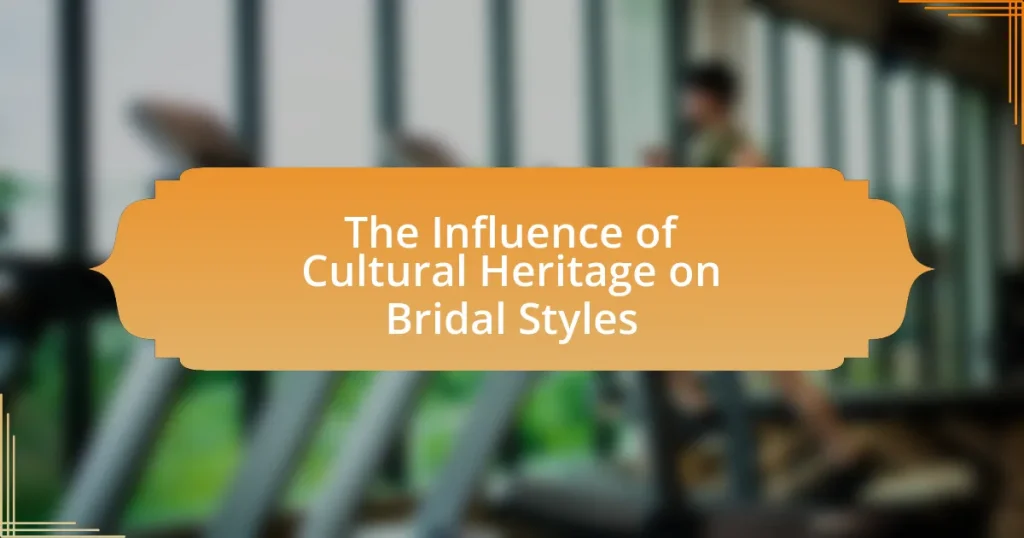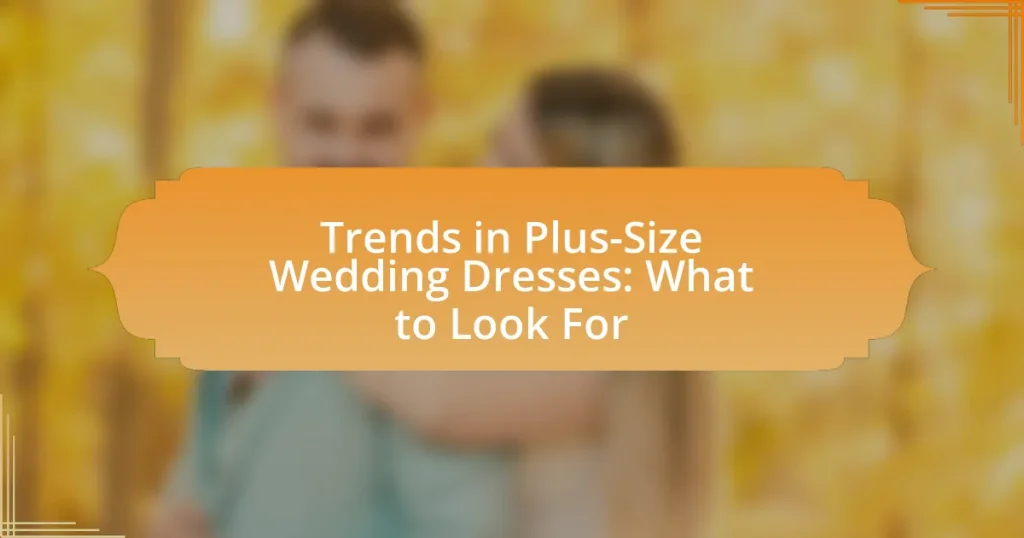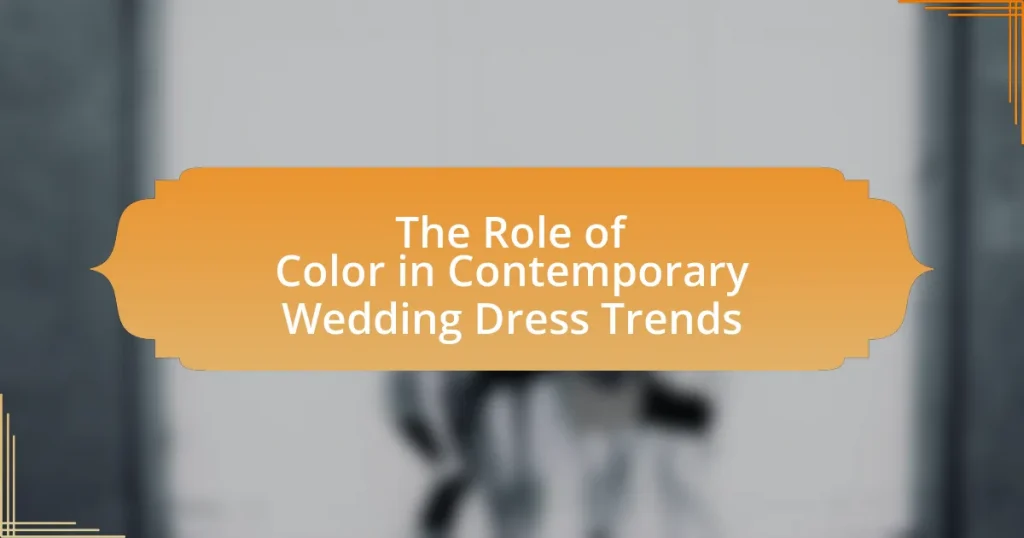The article examines the significant influence of cultural heritage on bridal styles, highlighting how traditions, symbolism, and regional materials shape wedding attire across various cultures. It discusses the impact of cultural identity on bridal fashion choices, illustrating how specific colors and designs reflect cultural values, such as the use of red in Asian weddings for good fortune and white in Western weddings for purity. Additionally, the article explores the role of globalization in blending traditional and contemporary styles, the importance of honoring cultural heritage in modern bridal fashion, and the resources available for brides seeking cultural inspiration. Key practices for celebrating cultural heritage in bridal attire are also outlined, emphasizing the integration of traditional elements and collaboration with artisans.
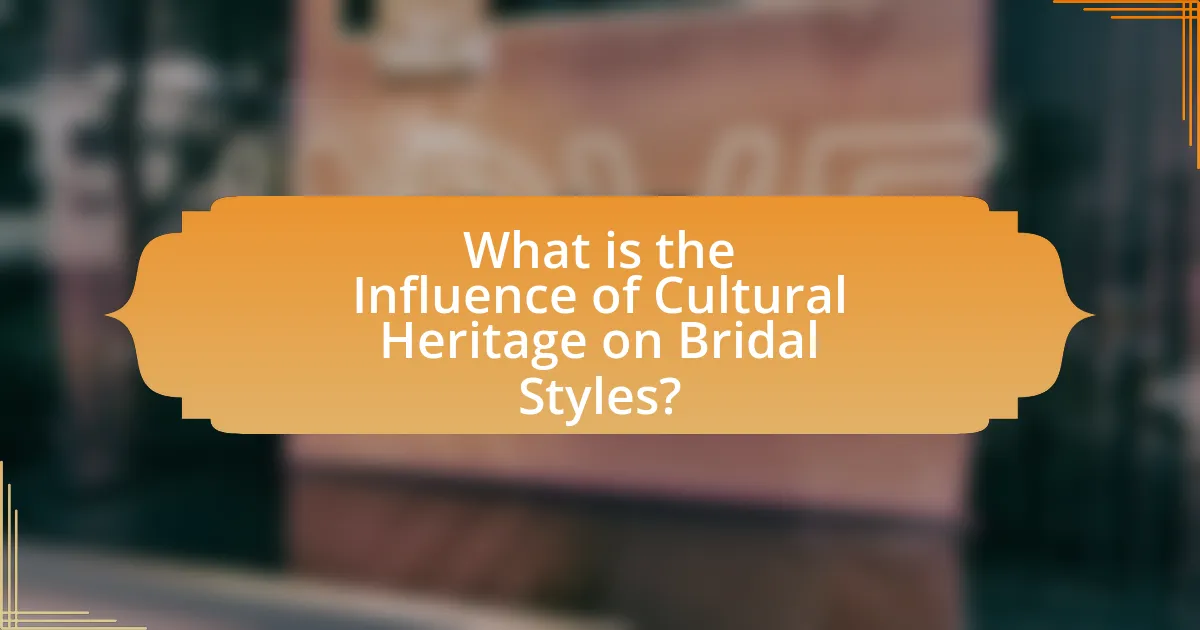
What is the Influence of Cultural Heritage on Bridal Styles?
Cultural heritage significantly influences bridal styles by dictating the materials, designs, and rituals associated with weddings. For instance, in Indian culture, bridal attire often includes vibrant saris adorned with intricate embroidery, reflecting traditional craftsmanship and regional variations. Similarly, in Western cultures, white wedding dresses symbolize purity and have historical roots dating back to Queen Victoria’s wedding in 1840. These styles are not merely aesthetic choices; they embody cultural narratives, values, and social norms, shaping how brides express their identity on their wedding day.
How does cultural heritage shape bridal fashion choices?
Cultural heritage significantly shapes bridal fashion choices by influencing the styles, colors, and materials used in wedding attire. For instance, traditional garments such as the Indian saree or the Chinese qipao reflect cultural values and historical significance, often incorporating specific colors like red for luck in Chinese culture or white for purity in Western traditions. Additionally, cultural rituals and customs dictate the design elements, such as embroidery patterns or symbolic motifs, which are integral to the identity of the bridal attire. This connection is evident in various cultures where bridal fashion serves not only as a personal expression but also as a representation of cultural identity and continuity.
What are the key elements of cultural heritage that influence bridal styles?
Key elements of cultural heritage that influence bridal styles include traditions, symbolism, and regional materials. Traditions dictate specific rituals and attire associated with weddings, such as the use of white dresses in Western cultures symbolizing purity, while red dresses in many Asian cultures symbolize good fortune. Symbolism plays a crucial role, as certain colors and designs carry significant meanings, like the use of floral motifs representing fertility. Regional materials, such as silk in Asia or lace in Europe, also shape bridal fashion, reflecting local craftsmanship and resources. These elements collectively inform the aesthetic and cultural significance of bridal styles across different societies.
How do traditions and customs impact bridal attire?
Traditions and customs significantly shape bridal attire by dictating the styles, colors, and materials used in wedding garments. For instance, in Western cultures, white dresses symbolize purity and are a tradition stemming from Queen Victoria’s wedding in 1840, while in many Asian cultures, red is favored for its associations with luck and prosperity. These cultural preferences influence not only the aesthetic choices but also the rituals surrounding the wedding, such as the incorporation of specific fabrics or embellishments that reflect regional heritage. The adherence to these customs ensures that bridal attire resonates with cultural identity and familial expectations, reinforcing the importance of tradition in the celebration of marriage.
Why is understanding cultural heritage important in bridal fashion?
Understanding cultural heritage is important in bridal fashion because it shapes the design, symbolism, and significance of bridal attire across different cultures. Bridal fashion often incorporates traditional elements that reflect the values, beliefs, and customs of a specific culture, such as the use of specific colors, fabrics, and styles that hold cultural meaning. For instance, in many Asian cultures, red is a symbol of good luck and prosperity, influencing the choice of bridal gowns. Additionally, recognizing cultural heritage allows designers to create garments that honor and respect these traditions, fostering inclusivity and appreciation for diverse backgrounds in the fashion industry. This understanding not only enhances the authenticity of bridal fashion but also connects individuals to their cultural roots, making the wedding experience more meaningful.
What role does cultural identity play in bridal style selection?
Cultural identity significantly influences bridal style selection by dictating the traditions, colors, and symbols that are incorporated into wedding attire. For instance, in many cultures, specific colors hold particular meanings; red is often favored in Chinese weddings for its symbolism of good fortune, while white is traditionally worn in Western weddings to represent purity. Additionally, cultural practices, such as the use of specific fabrics or adornments, reflect the heritage and values of the bride’s background. Research indicates that brides often choose styles that resonate with their cultural narratives, reinforcing their identity and familial connections during the wedding ceremony. This connection to cultural identity not only shapes individual choices but also preserves and honors longstanding traditions within communities.
How can cultural heritage enhance the meaning of bridal attire?
Cultural heritage enhances the meaning of bridal attire by embedding traditional symbols, colors, and styles that reflect the values and beliefs of a community. For instance, in many cultures, specific colors like red in Chinese weddings symbolize good fortune and joy, while white in Western cultures represents purity and innocence. These elements not only signify the couple’s cultural identity but also connect them to their ancestry and community traditions. Furthermore, bridal attire often incorporates unique craftsmanship and techniques passed down through generations, such as intricate embroidery or weaving patterns, which serve as a testament to the cultural history and artistry of a region. This deep-rooted significance transforms bridal attire from mere clothing into a powerful expression of cultural heritage and personal identity.
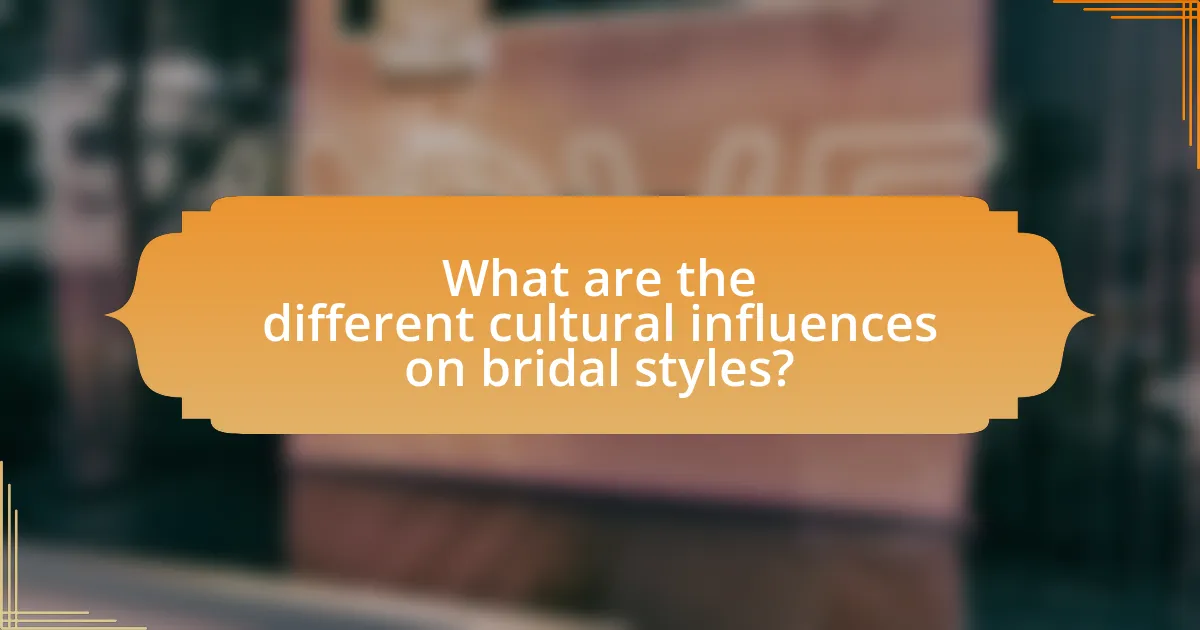
What are the different cultural influences on bridal styles?
Different cultural influences on bridal styles include regional traditions, religious practices, and historical customs. For instance, in Western cultures, white wedding dresses symbolize purity and have been popular since Queen Victoria’s wedding in 1840. In contrast, in Indian culture, brides often wear red or vibrant colors, reflecting auspiciousness and joy, with intricate embroidery and embellishments. Additionally, Chinese brides traditionally wear red dresses, symbolizing good fortune and happiness, often accompanied by gold accessories. These variations illustrate how cultural heritage shapes bridal attire, with each style carrying specific meanings and significance rooted in the respective traditions.
How do various cultures express their bridal styles?
Various cultures express their bridal styles through unique attire, rituals, and symbolism that reflect their traditions and values. For instance, in Indian culture, brides often wear vibrant red or gold saris adorned with intricate embroidery, symbolizing prosperity and fertility. In contrast, Western cultures typically feature white wedding dresses, representing purity and new beginnings, a tradition popularized by Queen Victoria in the 19th century. Additionally, African cultures may incorporate colorful fabrics and elaborate beadwork, showcasing community heritage and identity. These diverse expressions highlight how cultural heritage significantly influences bridal styles, with each tradition carrying its own historical and social significance.
What are the unique features of Western bridal styles?
Western bridal styles are characterized by their emphasis on white or ivory gowns, intricate lace detailing, and a variety of silhouettes such as A-line, ball gown, and mermaid. These styles often incorporate elements like veils, tiaras, and bouquets, reflecting a blend of tradition and modernity. The historical significance of the white wedding dress dates back to Queen Victoria’s marriage to Prince Albert in 1840, which popularized this color choice in Western cultures. Additionally, Western bridal styles frequently feature personalized touches, such as custom embroidery or unique accessories, allowing brides to express their individuality while adhering to cultural norms.
How do Eastern bridal traditions differ from Western ones?
Eastern bridal traditions often emphasize elaborate ceremonies, vibrant colors, and cultural symbolism, while Western traditions typically focus on simplicity, white gowns, and individual expression. For instance, in many Eastern cultures, such as Indian and Chinese, brides wear red or other bright colors, symbolizing good fortune and happiness, whereas Western brides traditionally wear white to symbolize purity. Additionally, Eastern weddings often include multiple days of festivities and rituals, such as the Mehndi ceremony in Indian culture, which involves intricate henna designs, while Western weddings usually consist of a single day of celebration with a focus on the ceremony and reception. These differences reflect the distinct cultural values and historical contexts that shape bridal customs in each region.
What are some examples of cross-cultural influences in bridal fashion?
Cross-cultural influences in bridal fashion include the incorporation of elements from various cultures, such as the use of red in Chinese weddings symbolizing good fortune, the adoption of Indian bridal jewelry like maang tikka and bangles, and the blending of Western white gowns with traditional African attire, such as kente cloth. These examples illustrate how global traditions shape contemporary bridal wear, reflecting a fusion of cultural significance and aesthetic preferences. For instance, the popularity of the white wedding dress in Western cultures has been embraced globally, while many brides now incorporate cultural symbols and colors from their heritage, showcasing a blend of personal and cultural identity in their wedding attire.
How has globalization affected traditional bridal styles?
Globalization has significantly influenced traditional bridal styles by introducing diverse cultural elements and trends, leading to hybridization and modernization of these styles. For instance, many brides now incorporate Western elements, such as white wedding dresses and modern accessories, alongside traditional attire, reflecting a blend of cultural practices. This shift is evidenced by the increasing popularity of destination weddings, where couples often choose to merge different cultural traditions, resulting in unique bridal looks that may not adhere strictly to historical norms. Additionally, global fashion trends disseminated through media and social platforms have accelerated the adoption of contemporary designs, impacting local bridal fashion industries and altering traditional practices.
What are the trends in fusion bridal attire?
Trends in fusion bridal attire include the blending of traditional and contemporary styles, often incorporating elements from various cultures. This trend reflects a growing preference for personalized and unique wedding outfits that resonate with individual identities. For instance, many brides are opting for lehengas paired with Western-style tops or gowns that feature intricate embroidery typical of traditional attire. Additionally, the use of unconventional colors, such as pastels and bold hues, is becoming popular, moving away from the traditional red and white. The integration of sustainable fabrics and ethical fashion practices is also on the rise, as brides seek to make environmentally conscious choices while celebrating their heritage.
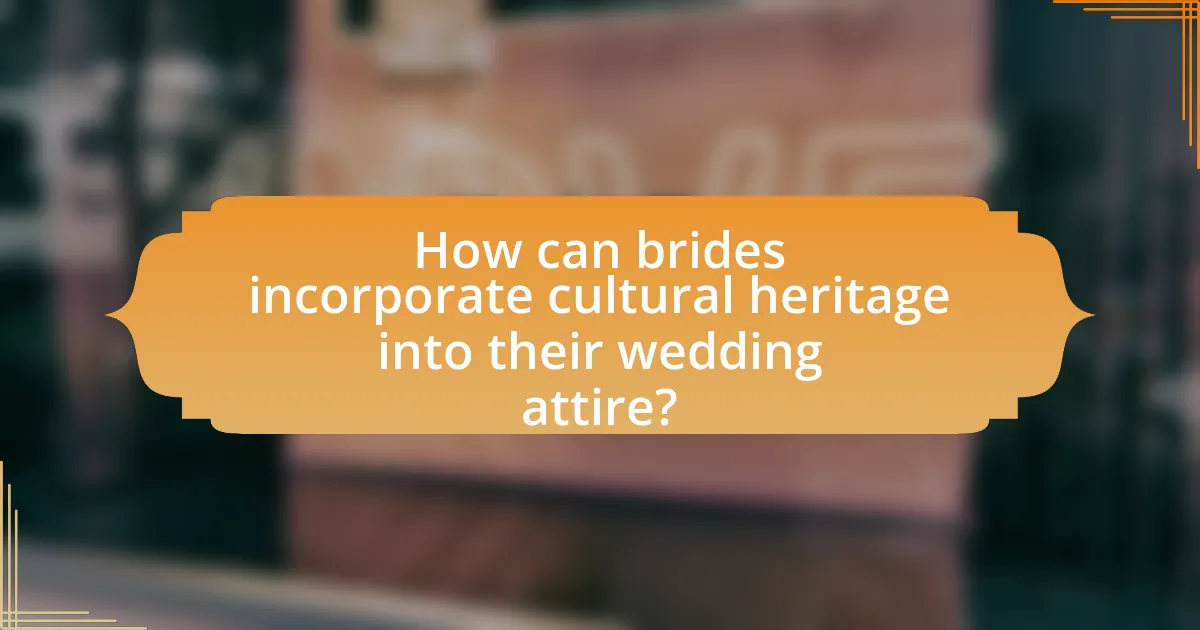
How can brides incorporate cultural heritage into their wedding attire?
Brides can incorporate cultural heritage into their wedding attire by selecting traditional garments, fabrics, and embellishments that reflect their cultural background. For example, a bride of Indian descent may choose to wear a saree or lehenga, which are rich in cultural significance and often feature intricate embroidery and vibrant colors. Additionally, brides can include cultural symbols or motifs in their attire, such as using specific patterns that represent their heritage. This practice not only honors their ancestry but also connects them to their family’s traditions, as many cultures have specific attire that signifies important life events like weddings.
What are some tips for blending cultural elements into modern bridal styles?
To blend cultural elements into modern bridal styles, incorporate traditional fabrics, patterns, and motifs that reflect specific cultural heritages. For example, using silk or brocade from Asian cultures can add richness, while incorporating African kente cloth patterns can introduce vibrant colors and symbolism. Additionally, consider integrating cultural accessories, such as jewelry or headpieces, that hold significance in the respective culture. Research indicates that 70% of brides seek to personalize their wedding attire, often looking to their heritage for inspiration, which reinforces the importance of these elements in creating a unique bridal look.
How can brides honor their heritage while choosing contemporary designs?
Brides can honor their heritage while choosing contemporary designs by incorporating traditional elements, such as fabrics, patterns, or motifs, into modern silhouettes. For example, a bride might select a contemporary gown that features intricate embroidery inspired by her cultural background, which not only reflects her identity but also aligns with current fashion trends. This approach allows for a blend of the old and the new, ensuring that the bride’s cultural significance is preserved while embracing modern aesthetics. Historical practices show that many cultures have successfully integrated traditional craftsmanship into contemporary fashion, demonstrating that such combinations can be both meaningful and stylish.
What accessories can enhance the cultural aspect of bridal attire?
Jewelry, headpieces, and traditional footwear can enhance the cultural aspect of bridal attire. Jewelry such as necklaces, earrings, and bangles often reflect cultural symbols and heritage, with specific designs representing different traditions. For example, in Indian culture, bridal jewelry is typically ornate and includes pieces like the maang tikka and jhumka, which signify marital status and cultural identity. Headpieces, such as veils or crowns, can also carry cultural significance; for instance, a Spanish mantilla or a Middle Eastern hijab can symbolize cultural heritage and tradition. Traditional footwear, like Indian juttis or Moroccan babouches, not only complements the bridal outfit but also showcases regional craftsmanship and cultural aesthetics. These accessories collectively contribute to the overall cultural representation of the bride’s heritage during the wedding ceremony.
What resources are available for brides seeking cultural inspiration?
Brides seeking cultural inspiration can access a variety of resources including cultural wedding blogs, social media platforms, and bridal magazines that focus on diverse traditions. For instance, websites like The Knot and WeddingWire feature sections dedicated to multicultural weddings, showcasing real weddings and cultural elements. Additionally, Pinterest serves as a visual platform where brides can explore themed boards related to specific cultures, allowing them to gather ideas for attire, decor, and rituals. Furthermore, local cultural organizations and community centers often provide workshops or events that celebrate traditional practices, offering firsthand experience and knowledge. These resources collectively support brides in incorporating cultural heritage into their wedding planning.
Where can brides find culturally inspired bridal designers?
Brides can find culturally inspired bridal designers through specialized boutiques, online marketplaces, and cultural fashion events. Many bridal boutiques focus on diverse cultural aesthetics, offering collections that reflect various heritages. Online platforms like Etsy and independent designer websites also showcase unique, culturally inspired bridal wear. Additionally, cultural fashion events and bridal shows often feature designers who specialize in traditional and modern interpretations of cultural attire, providing brides with a wide range of options that celebrate their heritage.
What role do bridal shows and exhibitions play in showcasing cultural heritage?
Bridal shows and exhibitions serve as vital platforms for showcasing cultural heritage by presenting traditional attire, customs, and practices associated with weddings from diverse cultures. These events allow designers and artisans to display garments that reflect historical significance and regional craftsmanship, thereby educating attendees about the cultural narratives behind each piece. For instance, bridal shows often feature traditional garments such as the Indian saree or the Chinese qipao, which embody specific cultural meanings and rituals. By facilitating direct interaction between cultural representatives and the audience, these exhibitions promote appreciation and understanding of various cultural heritages, reinforcing their relevance in contemporary bridal fashion.
What are the best practices for celebrating cultural heritage in bridal fashion?
The best practices for celebrating cultural heritage in bridal fashion include incorporating traditional fabrics, designs, and motifs that reflect the couple’s cultural backgrounds. For instance, using textiles like silk or brocade, which are often significant in various cultures, can enhance the authenticity of the bridal attire. Additionally, collaborating with artisans who specialize in traditional craftsmanship ensures that the garments are not only culturally relevant but also support local economies. Research indicates that 70% of couples prefer to include cultural elements in their wedding attire, highlighting the importance of heritage in modern bridal fashion. Furthermore, integrating cultural rituals and symbols into the wedding ceremony can deepen the connection to heritage, making the celebration more meaningful.
